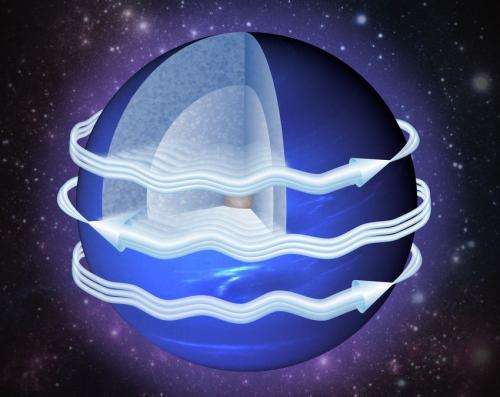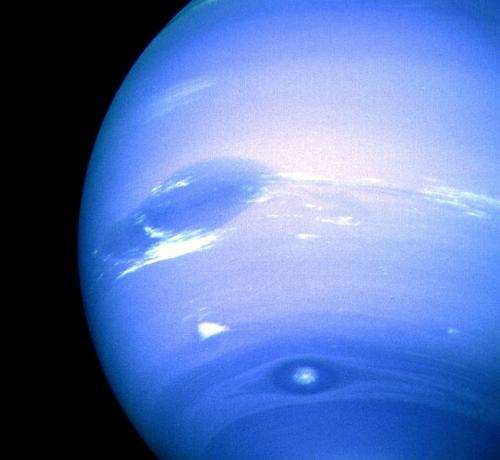May 16, 2013 report
Researchers find winds on Uranus and Neptune confined to thin atmosphere layer

(Phys.org) —A team of researchers from the U.S. and Israel has deduced that the winds that blow on Uranus and Neptune are confined to relatively thin atmospheric layers. In their paper published in the journal Nature, the group describes how they used data from Voyager 2, ground based satellites and models to work out the thickness of the weather systems on the two ice giants.
With the downgrading of Pluto, Neptune and Uranus are now listed as the planet's in our solar system the most distant from the sun. Because of that, the least is known about them. To date, just one spacecraft has flown close enough to either of them to offer useful information: Voyager 2 back in the 1980's. Scientists would like to know more of course—of particular interest are the bands of winds that blow at high speeds in the atmospheres of both planets. Are they fueled by mostly atmospheric conditions or by an unknown inner planetary dynamic? No one knows for sure, but work done in this latest effort suggests it's more likely the former.
To learn more about the weather systems going on with both planets, the research team dug up gravity data from the Voyager 2 missions, used current telescopes and created models to help identify the factors that contribute to the wind bands. They focused specifically on each planets' gravitational field, noting that variations can occur due to a variety of factors. Some of those include the amount of mass beneath a point being measured, how compressed the spherical nature of the planet is due to spin, and the amount of material held in the atmosphere by winds.

After analyzing all the data, the researchers concluded that the winds that blow on both planets, due so in a very thin layer in the atmosphere—no more than 600 miles deep. Because of the large size of the planets, the layers are proportionally very small—just 0.15 percent of the mass of Uranus, and 0.2 percent for Neptune. This suggests, the researchers propose, that the winds are mostly driven by atmospheric and surface conditions (possibly moisture evaporating and condensing) rather than some forces deep inside the planets icy interior.
Using gravity to estimate wind conditions on other planets is a new approach, one that will likely be applied to exoplanets now that it appears to have provided useful information about planets closer to home.
More information: Atmospheric confinement of jet streams on Uranus and Neptune, Nature 497, 344–347 (16 May 2013) doi:10.1038/nature12131
Abstract
The observed cloud-level atmospheric circulation on the outer planets of the Solar System is dominated by strong east–west jet streams. The depth of these winds is a crucial unknown in constraining their overall dynamics, energetics and internal structures. There are two approaches to explaining the existence of these strong winds. The first suggests that the jets are driven by shallow atmospheric processes near the surface, whereas the second suggests that the atmospheric dynamics extend deeply into the planetary interiors. Here we report that on Uranus and Neptune the depth of the atmospheric dynamics can be revealed by the planets' respective gravity fields. We show that the measured fourth-order gravity harmonic, J4, constrains the dynamics to the outermost 0.15 per cent of the total mass of Uranus and the outermost 0.2 per cent of the total mass of Neptune. This provides a stronger limit to the depth of the dynamical atmosphere than previously suggested, and shows that the dynamics are confined to a thin weather layer no more than about 1,000 kilometres deep on both planets.
Journal information: Nature
© 2013 Phys.org





















